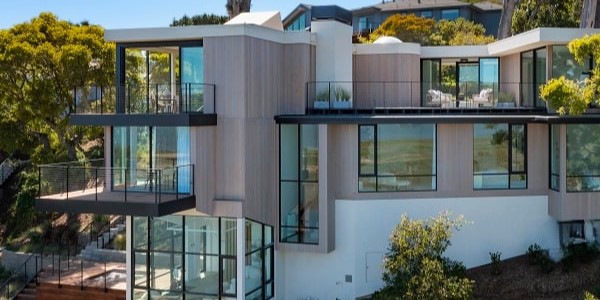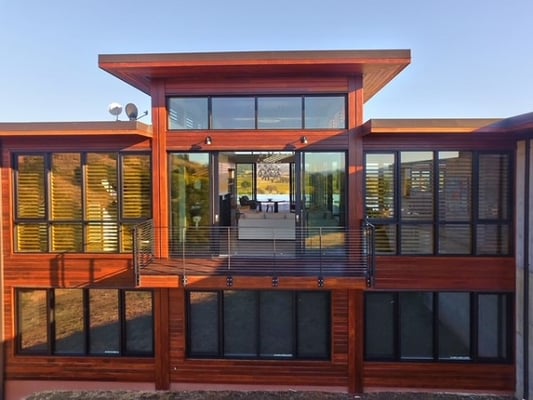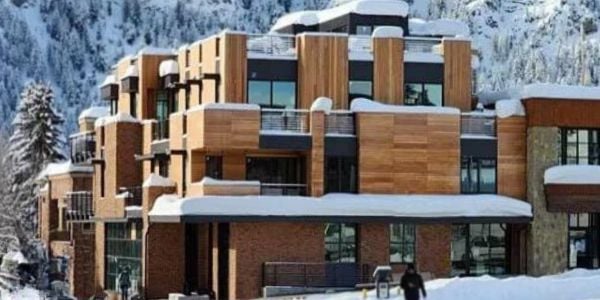

The exterior of wood and steel wrap the expansive windows that give Bay views from on all sides of the home.
Setting Premium Siding Standards
From the start, Tom's top priority was finding a fire-resistant wood siding that could withstand the Bay Area's high moisture and humidity for the long haul, all while looking great. He also needed material that could be stained or painted.
Tom and architect, Ron Sutton of Sutton Suzuki Architects, worked closely with the homeowners. They wanted a real wood siding for house to beautifully contrast with the metal and stucco elements in the home's design.
Traditionally, homes in the Bay Area used Western Red Cedar or Redwood for wood exteriors. However, both Cedar and Redwood are soft woods that can easily dent. While that's fine for a rustic look, this project demanded a polished, elegant vertical siding design that wouldn't show imperfections.
"The bottom line is the performance. It's been installed [for several months] and performed in heat and wet without buckling, cupping, or having any problems.”
— Tom Wharton, Co-Owner, T J Built Construction, Inc.

Mataverde SaferWood ThermaWood FR Hem-Fir Siding material, unfinished. A good example of the deepened color of the wood grain from the heat modification, before any clear of color finish is applied.
 A view from the water looking at the private dock and up the hillside of the completed home. The wood with a light custom stain is a glowing choice for the water front vibe, and to warm and soften the cold steel, stucco and glass.
A view from the water looking at the private dock and up the hillside of the completed home. The wood with a light custom stain is a glowing choice for the water front vibe, and to warm and soften the cold steel, stucco and glass.
Discovering a Superior Siding Solution
That's when Tom talked to Chris Eddy at Golden State Lumber, a trusted contact and authorized Mataverde dealer for years. Chris immediately recommended Mataverde SaferWood ThermaWood FR Hem-Fir. It offered the stunning look of Cedar but with the superior stability Tom needed. Chris noted that once contractors and architects saw samples, they chose it over clear vertical grain Cedar, especially since it met Tom's standards at about half the cost of clear Western Red Cedar.
Robby Myer, Golden State Lumber's Architect Concierge, also highlighted ThermaWood FR Hem-Fir's popularity among local architects. He emphasized that it's a genuine wood siding with both a clear vertical siding grain and IWUI and WUI fire-retardant approvals. Robby called it a "beautiful product that meets the visual aesthetic that architects want with the high quality, consistent grain structure that is dominating the luxury home building landscape."
 A close look at ThermaWood FR Hem-Fir thermally modified siding material, with a clear finish, it is no surprise why it is often thought to be Western Red Cedar on first look. See how the slightly darkened color is enhanced by finishing?
A close look at ThermaWood FR Hem-Fir thermally modified siding material, with a clear finish, it is no surprise why it is often thought to be Western Red Cedar on first look. See how the slightly darkened color is enhanced by finishing?
Tom was intrigued by the proprietary thermal modification and fire-retardant treatment process used for Mataverde SaferWood ThermaWood FR Hem-Fir. This process makes the wood harder and much more resistant to moisture and insects than other untreated softwoods like Hemlock, Fir, or Cedar.
The modification is done using only heat and steam in a special kiln, making it completely non-toxic. This results in siding boards that are easier to work with, unlike the brittleness you sometimes find in pressure-treated lumber. Plus, by removing natural sugars, the wood gains excellent resistance to insect damage.
Crucially for Tom, ThermaWood FR Hem-Fir siding boards are incredibly resistant to cupping, splitting, and denting. This was vital for maintaining the long-lasting, polished look of the home's extensive vertical wood siding.
Is Mataverde SaferWood right for your project? Request a quote today.
Customizable Aesthetics: Paintable and Stainable
A key advantage of Mataverde SaferWood sidings is that - even with its fire treatment - it can still be stained or painted. A feature highly sought after by architects and builders. For this project one of the homeowners, originally from the East Coast, envisioned an exterior color reminiscent of classic weathered saltbox homes but with a modern California twist.
Working closely with both the architect and homeowner, Tom developed a custom color oil-based stain. This stain applied perfectly to the siding, resulting in a unique finish Tom dubbed the "pastel California saltbox."
Explore more Mataverde SaferWood siding ideas in our project photo gallery here
Exemplary Performance in Challenging Conditions
The wood siding was installed vertically with precise measurements, especially where it met the steel and stucco elements. Tom emphasized that the design allowed for zero tolerance for any boards changing shape and disrupting the clean lines.
Tom regularly inspected the ThermaWood FR Hem-Fir siding for any changesDespite nearly a year of unusually wet weather after the installation, Tom regularly inspected the ThermaWood FR Hem-Fir siding for any changes. None were found.
Tom was direct about his expectations and the outstanding results. "Cupping is always my anxiety, and we haven't seen any," he stated. "The bottom line is the performance. It's been installed for several months and performed in heat and wet without buckling, cupping, or having any problems."
He especially valued the stability of the thermally modified Hem-Fir. Having previously relied on Western Red Cedar, Tom was pleased that ThermaWood FR cuts and handles similarly, but with added durability. This significantly boosted its appeal for him in this exterior house renovation.
 A side view of the top floor
A side view of the top floor
Mataverde SaferWood, The Perfect Partner
To tie it all together at the end of our conversation, we asked Tom a few specific questions about his experience with Mataverde SaferWood Siding and our team at Mataverde Sustainable Decking and Siding Solutions.
Q: Would Tom choose Mataverde SaferWood ThermaWood FR Hem-Fir again for future projects? A: Without hesitation, Tom answered. "Yes, and I would use Mataverde again."
Q: What was the final deciding factor in choosing ThermaWood FR Hem-Fir over Western Red Cedar? A: “Price. Price over Western Red Cedar," declared Tom, giving the team a comparable aesthetic at a much lower cost for fire-resistant siding.
Q: What did the Mataverde team do to gain your trust? A: The team "reliably hit the supply chain” to meet the project timeline, including on-time delivery. “That’s very important." "It was properly milled, it came to us ‘clean’, and it's coming out of the mill having been treated [with code compliant fire retardant].”
Q: Was Ron Sutton, architect, pleased with the end result? A: The architect had “no complaints” about the finished execution. Tom added that Ron’s firm and their photographer were on site as we spoke to capture the home for their portfolio.
Q: In the end, the homeowner's satisfaction is the goal. How do they feel about the exterior of their new home? A: “Happy, very happy.”
Building a custom home is as much about craftsmanship as it is about using the right materials. Tom Wharton is a respected, experienced, and knowledgeable home builder. He did his research and then trusted a new siding material, based on the promises it made to meet his high standards. As he said, ThermaWood FR Hem-Fir exceeded his expectations and he will not hesitate to use it in future house renovation projects.
Do you have a wood siding project that would benefit from all the advantages of Mataverde SaferWood ThermaWood FR Hem-Fir Siding? Let us earn your trust, too. Contact our team today, we’re happy to help with your siding ideas!
Ready for more information?
Related Posts









